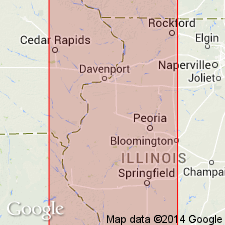
- Usage in publication:
-
- Millbrig Bentonite Bed
- Modifications:
-
- Original reference
- Dominant lithology:
-
- Bentonite
- AAPG geologic province:
-
- Wisconsin arch
Summary:
Pg. 43-44. Millbrig Bentonite Bed of Glencoe Member of Spechts Ferry Formation. Present in Illinois and Wisconsin. Occurs at or near base of the Glencoe Member, which overlies the Castlewood Member of the Spechts Ferry Formation. Described as light-gray bentonite clay with orange staining. Thickness at type is 0.10 m. Age is Middle Ordovician.
Type section: Millbrig Southeast section, along east bank of Galena River, 1.6 km southeast of Millbrig, in center of sec. 34, T. 29 N., R. 1 E., Jo Daviess Co., IL. Named from Millbrig.
Source: US geologic names lexicon (USGS Bull. 1564, p. 107-108); supplemental information from GNU records (USGS DDS-6; Reston GNULEX).
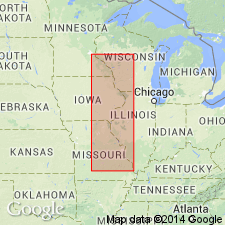
- Usage in publication:
-
- Millbrig K-bentonite Bed
- Modifications:
-
- Areal extent
- AAPG geologic province:
-
- Sioux uplift
- Iowa shelf
- Ozark uplift
Summary:
The Millbrig has consistent and diagnostic chemical composition that can be recognized throughout study area from St. Paul, MN, to Ste. Genevieve, MO, including eastern IA.
Source: GNU records (USGS DDS-6; Reston GNULEX).
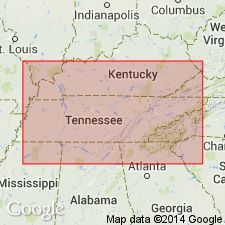
- Usage in publication:
-
- Millbrig K-bentonite bed
- Modifications:
-
- Areal extent
- AAPG geologic province:
-
- Appalachian basin
Summary:
In this report authors extend the correlation of the Deicke and Millbrig K-bentonite beds from MO across KY and the central basin in TN to northeast AL and southwest VA using data from outcrops, cores, and wireline logs. They are equivalent to beds previously called T-3 or Pencil Cave and T-4 or Mud Cave metabentonites and thus are Ordovician chronostratigraphic marker horizons throughout much of the eastern Midcontinent. Both beds thicken toward the southeast indicating a volcanic source area east of SC. The areal extent of known correlatives of the Deicke and Millbrig is estimated to be at least 600,000 square km. The volume of both beds suggests they rank among the largest documented air-fall ash deposits. The Deicke and Millbrig occur in the Carters Limestone in TN, GA, and AL, in the Eggleston Formation in VA, and in the Tyrone Limestone in KY. It is proposed in this report that the names Deicke and Millbrig K-bentonite beds "take precedence for usage in describing beds formerly called T-3 or Pencil Cave and T-4 or Mud Cave."
Source: GNU records (USGS DDS-6; Reston GNULEX).
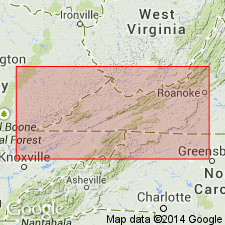
- Usage in publication:
-
- Millbrig K-bentonite Bed
- Modifications:
-
- Revised
- Areal extent
- AAPG geologic province:
-
- Appalachian basin
Summary:
Three Rocklandian K-bentonite beds occur in the Valley and Ridge province of southwest VA, southeast WV, and northeast TN. The older two are identified as the Deicke and Millbrig K-bentonite Beds, mapped previously in the Upper Mississippi Valley. The Deicke (oldest of the three beds) is equivalent to K-bentonite V-3 in the central Valley and Ridge, K-bentonite R-7 in the Powell Valley, and K-bentonite T-3 of the Cincinnati Arch, also called Pencil Cave bentonite. The Millbrig is equivalent to K-bentonite V-4 in the central Valley and Ridge, K-bentonite R-10 in the Powell Valley, and K-bentonite T-4 of the Cincinnati Arch, also called Mud Cave bentonite. The youngest bed has not been correlated with a K-bentonite in the Upper Mississippi Valley, but is known widely as the informal bed V-7. The Millbrig and V-7 are present in the Bays Formation in the eastern belt, while the Deicke occurs in or just above the redbeds of the Moccasin Formation (Walker Mountain Sandstone [Member] in the New River Valley) and does not extend eastward into the Bays. At Hagan, and several other places in southwestern VA, the Deicke and Millbrig occur in the Eggleston Formation. Using the bentonites as time lines, it has been determined that the bases of the Eggleston, Bays, and Trenton ("Martinsburg") Formations become younger to the northeast. The Walker Mountain Sandstone Member of the Moccasin and Bays Formations also becomes younger to the northeast. Correlation charts. Cross sections. Measured sections in Appendix.
Source: GNU records (USGS DDS-6; Reston GNULEX).
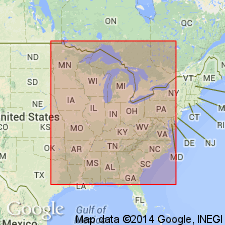
- Usage in publication:
-
- Millbrig K-bentonite
- Modifications:
-
- Overview
Summary:
Biostratigraphical, geochemical, isotopic, and paleogeographic data all suggest that the Millbrig K-bentonite of North America is the same as the "Big Bentonite" of Baltoscandia. This is the first time that the same K-bentonite has been identified on both sides of the Atlantic. Eruption produced at least 340 cubic km of ash that was deposited in a layer up to 1 to 2 m thick over several million square km. A possible 800 additional cubic km may have fallen into the Iapetus Ocean. Age of the bentonite is middle Caradocian (early Mohawkian).
Source: GNU records (USGS DDS-6; Reston GNULEX).

- Usage in publication:
-
- Millbrig K-bentonite Bed
- Modifications:
-
- Revised
- AAPG geologic province:
-
- Appalachian basin
Summary:
According to the author, the terms Deicke K-bentonite Bed and Millbrig K-bentonite Bed satisfy the requirements of the North American Stratigraphic Code and are used in this report as formal names. Reinterpretations of earlier correlations in the Valley and Ridge of AL and GA are presented in this report. (See Haynes, 1992, for reinterpretations in the VA Valley and Ridge.) The Deicke and Millbrig occur in the Tyrone Limestone of the uppermost High Bridge Group in central KY; the Carters Limestone of the uppermost Stones River Group in central and southeast TN and northwest GA; the upper Moccasin and lower Eggleston Formations in southwest VA, southeast WV, and northeast TN, and the upper Stones River Group (undivided) and Chickamauga Limestone in AL. Both the Deicke and Millbrig occur in the Colvin Mountain Sandstone in AL, but only the Deicke has been found in the Colvin Mountain in GA and the Bays Formation in southeast TN. In northeast TN, and southwest VA only the Millbrig is present in the Bays. The Deicke and Millbrig are now recognizable in both carbonate and clastic strata of the Valley and Ridge province from Birmingham, AL, to Roanoke, VA. Absolute age based on 40Ar/39Ar values from biotites determined the mean isotopic age of the two beds is 454.1+/-2.1 Ma (Kunk and Sutter, 1984). Fission track dating of zircons determined a mean age of 453+/-3 Ma (Ross and others, 1982). Age, then, is clearly Rocklandian. Report includes measured sections and correlation charts.
Source: GNU records (USGS DDS-6; Reston GNULEX).

- Usage in publication:
-
- Millbrig Bentonite Bed*
- Modifications:
-
- Overview
- AAPG geologic province:
-
- Cincinnati arch
Summary:
Millbrig Bentonite Bed (Willman and Kolata, 1978) overlies Deicke Bentonite Bed (discussed in MN). Age is Middle Ordovician (Champlainian, Rocklandian).
Source: GNU records (USGS DDS-6; Reston GNULEX).
For more information, please contact Nancy Stamm, Geologic Names Committee Secretary.
Asterisk (*) indicates published by U.S. Geological Survey authors.
"No current usage" (†) implies that a name has been abandoned or has fallen into disuse. Former usage and, if known, replacement name given in parentheses ( ).
Slash (/) indicates name conflicts with nomenclatural guidelines (CSN, 1933; ACSN, 1961, 1970; NACSN, 1983, 2005, 2021). May be explained within brackets ([ ]).

